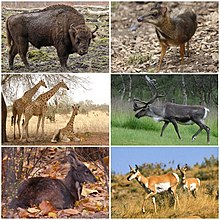| Ruminants Temporal range:
| |
|---|---|

| |
| Scientific classification | |
| Domain: | Eukaryota |
| Kingdom: | Animalia |
| Phylum: | Chordata |
| Class: | Mammalia |
| Order: | Artiodactyla |
| Clade: | Cetruminantia |
| Clade: | Ruminantiamorpha Spaulding et al., 2009 |
| Suborder: | Ruminantia Scopoli, 1777 |
| Infraorders | |
Ruminants are herbivorous grazing or browsing artiodactyls belonging to the suborder Ruminantia that are able to acquire nutrients from plant-based food by fermenting it in a specialized stomach prior to digestion, principally through microbial actions. The process, which takes place in the front part of the digestive system and therefore is called foregut fermentation, typically requires the fermented ingesta (known as cud) to be regurgitated and chewed again. The process of rechewing the cud to further break down plant matter and stimulate digestion is called rumination.[2][3] The word "ruminant" comes from the Latin ruminare, which means "to chew over again".
The roughly 200 species of ruminants include both domestic and wild species.[4] Ruminating mammals include cattle, all domesticated and wild bovines, goats, sheep, giraffes, deer, gazelles, and antelopes.[5] It has also been suggested that notoungulates also relied on rumination, as opposed to other atlantogenatans that rely on the more typical hindgut fermentation, though this is not entirely certain.[6]
Ruminants represent the most diverse group of living ungulates.[7] The suborder Ruminantia includes six different families: Tragulidae, Giraffidae, Antilocapridae, Cervidae, Moschidae, and Bovidae.[4]
- ^ Cite error: The named reference
Clauss2014was invoked but never defined (see the help page). - ^ "Rumination: The process of foregut fermentation". Archived from the original on 19 July 2013. Retrieved 19 December 2013.
- ^ "Ruminant Digestive System" (PDF).
- ^ a b Fernández, Manuel Hernández; Vrba, Elisabeth S. (1 May 2005). "A complete estimate of the phylogenetic relationships in Ruminantia: a dated species-level supertree of the extant ruminants". Biological Reviews. 80 (2): 269–302. doi:10.1017/s1464793104006670. ISSN 1469-185X. PMID 15921052. S2CID 29939520.
- ^ Fowler, M.E. (2010). "Medicine and Surgery of Camelids", Ames, Iowa: Wiley-Blackwell. Chapter 1 General Biology and Evolution addresses the fact that camelids (including camels and llamas) are not ruminants, pseudo-ruminants, or modified ruminants.
- ^ Richard F. Kay, M. Susana Bargo, Early Miocene Paleobiology in Patagonia: High-Latitude Paleocommunities of the Santa Cruz Formation, Cambridge University Press, 11 October 2012
- ^ "Suborder Ruminatia, the Ultimate Ungulate".